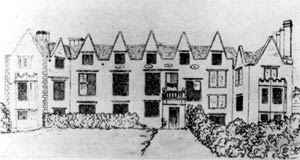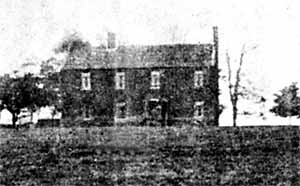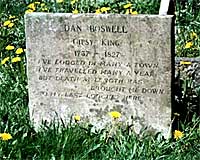Small tithes
It is recorded in 1579 that the vicarage of Selston was endowed with the small tithes only, and that these were worth but £7 yearly, the advowson belonging to Lady Dixie who was resident locally. Under Elizabeth I, Sir Charles Moryson had a coal mine here, and with Sir John Byron added to the activities of Selston by erecting iron-mills.
English ambassador to the court of France and one-time secretary to Sir Thomas Cromwell—the "hammer of the monks"—Sir Charles made his residence at Watford and by his will of 1597, he excluded his wife from all benefits bequeathed by him to her in the event of her attempting to dispossess the family tenantry on his Selston estate. With coal-mines and the production of lead and iron, Selston was already an industrial village under "Good Queen Bess" and it is not surprising that at the end of her reign, the population of the parish was about 625.
Selston sued, levied and indicted
It was not all toil in Elizabethan Selston. In 1579 its company of actors performed at Nottingham before the mayor, who rewarded them with 8d., a moderate sum which appears to have been acceptable as they were there again for another 8d. in the following year.
Attendance at their parish church was compulsory by law, but in 1587 the churchwardens reported to the archdeacon that Humphrey Walkinson was very negligent in coming to divine service and was given to drinking and was a drunkard.
They added that another parishioner, Francis Hoson, was also "negligent in coming to the church." A few years later, a collier was indicted at the sessions for harbouring vagrants, and another was cited in the ecclesiastical court "for draining water from the coal pitte on the Sabbath Daye."
Under the date of 1641, the parish register recorded that Selston Hall was henceforth to render increased tithes in kind; hemp, flax, hops, garden and orchard fruits, poultry and eggs, all coming under the new rule, but ere the results became apparent the Civil War broke out. The landowners were ardent cavaliers and they paid for their loyalty.
Tithes and levies
In 1647, Selston was assessed to pay £2 10s. 6d. towards the cost of maintaining Parliamentary forces, and its comparative importance is shown by the smaller contributions exacted elsewhere, Sutton being called upon to pay only £1 19s 8d., Kirkby £2 2s. 9d., Linby 13s. 2d. and Hucknall Torkard £1 9s. 8d. In addition Selston had to meet a Royalist levy of £100.
A Pusey heiress conveyed the family interests at Selston by marriage to one of the Willoughby family, and Lord Capell's inheritance passes to the Earl of Clare's descendants who owned it in Thoroton's time, and in the church survey of 1650, it was found that the rectory was worth £80 a year and the vicarage £10, but Lady Dixie had apparently forfeited the advowson (perhaps as a royalist) as the church income (like that of Hucknall, through the delinquency of Sir John Byron) was sequestered until the Restoration.
Quakers abused
The vicar was "a preaching minister." So, too, was his successor, the Rev. Charles Jackson, who hard upon his induction in 1651 reviewed and increased the tithes.
The objection of the Quakers to pay tithes was possibly the cause of his mishandling of Elizabeth Hooton of Skegby, the first lady preacher of that sect, who, according to Bresse's "Sufferings of the Quakers" when she was "passing quietly on the road, she was met by one Jackson, priest of Selston, who abused her, beat her with many blows, knocked her down, and afterwards put her into the water."
This exponent of muscular Christianity conformed at the Restoration, but was nevertheless ejected from the living in 1662, and became Congregational minister at the chapel founded at Selston in 1670.
Ejected curate
It was officially reported that in 1669, Selston was free from conventicles and this immunity from Dissent was confirmed by the curate (who was also the Vicar of Annesley) in 1676, but in 1693, the churchwardens here presented a parishioner for "attending a conventicle believed to be held at Sutton by old Mr. Tuke, the ejected curate there."
The Pusey inheritance descended to Wm. Willoughby of South Muskham who married Timothy's daughter, and their son and heir was Sir William Willoughby, Bart., who made residence at Selston and was aged 38 in 1661 when he certified his pedigree. A person of some note, he was "of the Privy Chamber to King Charles the Second in ordinary."
 |
| Selston Hall in the 18th century. |
 |
| Selston Hall Farm in 1933. |
Although Thoroton is silent concerning the Hall, such a residence then existed, but little is known of its history. Erected sometime in the late Tudor age, it is thought probably by a member of the Jay or Willoughby family, Selston Old Hall was successively the home of the Puseys, and the Dixies. By about the beginning of the 19th century, it had fallen into neglect and decay; its former, glories were forgotten and what was left of the mansion, perched on the crown of the hill, was converted into a farmhouse, which preserves the original wide staircase and its elaborately carved newel-post.
Selston was one of the parishes sued by the Southwell Chapter in 1630 for non-payment of its Whitsun offering, still two shillings as in the time of Henry II. By the 17th century, it had four inns to satisfy the requirements of its increasing population, and among the more curious annals of that period is the record that in 1630 the village shoemaker was prosecuted for the offence of "Putting horse leather into boots."
Road holes
In 1693 occur indictments for the evil condition of the highways— which doubtless suffered through the coal traffic. This was a recurrent, if not chronic defect, and in 1769, five men of the village were sued for digging holes in the roads at Greasley for material with which to repair their parish roads.
Hosiery trade brought boom to Selston
THE Fellows family of banking fame were of Selston and Felley, and in "County Pedigrees" it is suggested that its "first ascertained ancestor was Benjamin Fellows of the City of London" who died in 1695. His wife is said to have died at Derby on her way from London to her home in Selston, where she had some property, and their son, who made a fortune, became Mayor of Nottingham in 1755. The Rev. Robert Fellows who was instituted to Greasley rectory in 1506 was probably of the Selston family; and there was a Wm. Fellow who was a dean of Jackson's Puritan Church in the early days of the Restoration.
There was a Nonconformist congregation here in 1717, but it appears to have vanished by 1743, when the living was vacant, but two years later Vicar Wayne testified his loyalty by contributing five guineas to the anti-Jacobite fund.
Rapidly growing
Framework knitting was about this time introduced and hosiery manufacture became a permanent addition to the industries of the already busy village. There was a population of 833 in 1801, and 68 houses, the same as Basford, while Hucknall had 77, Bulwell 49, Linby 33, and Newstead 16. In 1793, the inhabitants had numbered only 524, but it was rapidly increasing and during the previous five years, it had witnessed 117 births and 71 burials. The last census (1951) revealed 9,691, and the total to-day is estimated at 10,000 or more.
Church in decay
Stretton, who was here with his notebook in 1813, described the church as in a sore state of decay. The pulpit lay in the chancel, the font lay broken in the churchyard, and the chancel, he said, was "far in decay." Subsequently, the walling developed cracks, and in 1899, the fabric was completely restored.
"Now," says Professor Pevsner (1951), "the exterior of the church looks entirely new, yet upon entering it one is in a building exceptionally of one piece. It must be all of the 13th century." But other authorities are of the opinion that the north arcade and the south porch date from the 12th century. The lower stages of the tower are of the 14th century and the upper part from the following century, to which also belong the clerestory.
Font rescued
The chancel is Early English of the reign of Henry III, but a recess below the east window is of later insertion, and Mr. Henry Gill suggested that it held a glazed picture illuminated by altar lights, as is known to have been the case at Hickling. The noble south porch still preserves remains of the hook and chain once used to keep cattle out of the sacred building.
The Norman font has been rescued from service as the horse-trough of an inn, and in the tower is the royal coat-of-arms, which probably once was displayed on the rood-screen or on the chancel arch.
Another feature of interest is the fine Jacobean altar-table, which after many mundane vicissitudes was rescued by Vicar Heanor and restored to its original position. The same vicar also recovered the shawm which led the singing in the church for more than a century. High on the chancel wall is the casque or steel helmet, and banner of a Willoughby of the 17th century. The finely carved pulpit is modern, and a window preserves the memory of nearly fifty men who fought and died in the war 1914-18.
Many remains of the venerable buildings have been preserved and a number of sepulchral slabs, some with quaint carvings of older time, have been built into the walls. Some table tombs have also surveyed. The bells were re-cast in 1905. Until enclosures invaded the wastes and commons, this district was attractive to the gipsies who formed camps, hereabouts, especially in the rear of the pinfold at Selston.
 |
| Dan Boswell's grave in Selston churchyard.. |
At an encampment near Bestwood in 1823, their "King" Dan Boswell, died and after interment inside Eastwood and Selston had been refused, the body was buried near the tower in Selston churchyard in the presence of a large concourse of gipsies and other spectators.
According to tradition, he gave his daughter a quart measure full of golden guineas at her wedding by way of dowry.
Selston swept by riots. But police found parish asleep
Under the Act of 1813 some 25 acres were enclosed and by a rectification of boundaries this parish was brought up to the Erewash, which here divided Notts, from Derbyshire. Another important event was the construction in 1817 of a primitive railroad linking Mansfield with a quay on the Erewash at Pinxton. Gravitation carried heavy traffic downhill and horse-power did the rest.
Part of this "line" passed through Selston, near Pinxton. The speed may be estimated from the fact that men walked beside the wagons and braked the wheels with wood if they went too fast downhill. On market days a coach was added for the convenience of travellers.
Local charities
In 1829, the Charity Commissioners reported on the local charities, which, if small, were numerous; doles of money or bread being distributed on Easter Monday, Christmas Day and New Year's Day. One of the charities had not been honoured by payment since 1817.
There were 191 stocking frames at work in Selston in 1844, and we are told that the work was arduous, uncertain and ill-paid. So late as 1906 two frames were still in active operation.
It is related that when the police were called in to quell the disorder there was nobody to be seen out of doors, and everybody appeared to be asleep in bed. Arrests were made and some of the offenders were punished, but the magistrates were divided in their opinions and the accused, men were accorded the benefit of the doubt.
By 1885, the principal landowners were Lord Cowper, the Earl of Mexborough, and the trustees of the late Sir Wm. Dixie Bart., and in 1922 when the trustees of the late Earl Cowper and the Earl of Mexborough were lords of the manor, Selston was a busy township with collieries, gas ovens, tar works and iron foundries.
Coins in bread
Old customs have lingered at Selston, and in 1919 seventy loaves of bread each containing a coin were being distributed annually from a tombstone in the churchyard, and the vicar was preaching once a year from the church tower. The ancient Tithe Barn, now a dwelling house, still exists in Pond Yard near the church. It may be mentioned that the enclosure here in 1877 was the last to be undertaken in Notts., and under the provisions of the Act every road was to be of a minimum width of 30ft.
As the parish is reputed to have thirteen miles of roads, to say naught of 94 miles of footpaths, it may be questioned if this mileage is exceeded in any parish in the country.
